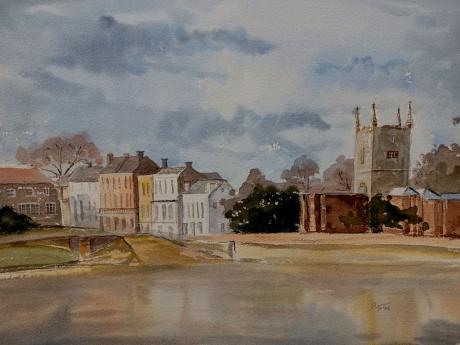" P Yates" and inscribed on the reverse
Unframed
Isleworth is a town located within the London Borough of Hounslow in West London, England. It lies immediately east of the town of Hounslow and west of the River Thames and its tributary the River Crane. Isleworth's original area of settlement, alongside the Thames, is known as 'Old Isleworth'. The north-west corner of the town, bordering on Osterley to the north and Lampton to the west, is known as 'Spring Grove'.
Isleworth's former Thames frontage of approximately one mile, excluding that of the Syon Park estate, was reduced to little over half a mile in 1994 when a borough boundary realignment was effected in order to unite the district of St Margaret's wholly within London Borough of Richmond upon Thames. As a result, most of Isleworth's riverside is that part overlooking the 8.6-acre (3.5 ha) islet of Isleworth Ait: the short-length River Crane flows into the Thames south of the Isleworth Ait, and its artificial distributary the Duke of Northumberland's River west of the Isleworth Ait, one of two Colne distributaries constructed for aesthetic reasons in the 1600–1750 period.
Much of Isleworth became orchards in the 18th century (including part of Hugh Ronalds' renowned nursery), and then market gardens in the 19th century, supplying the London markets. Lower Square and Church Street still have buildings dating from the 18th and early 19th centuries. A striking element of this period was the establishment in Isleworth of many mansions and large houses, principally for aristocrats and high achievers. This phenomenon arose owing mainly to the collection of royal and noble residences and ecclesiastical establishments that already existed nearby. The subject is examined in depth in the "Notable houses" section.
There is evidence of a Black community in Isleworth in the 18th century. This community was primarily made up of enslaved people of colour, from Africa, Asia or the Caribbean. Some of these people had fled from bondage and chose to seek their freedom in the streets of London. With very few exceptions, little is known about people of colour in 18th century London. However, as a result of contemporary sources like advertisements seeking the capture and return of runaway slaves, an insight can be gained into the lives of two people, Marina Dellap and Prince, who resided in the area in 1765.
All Saints' Church is the oldest parish church in Isleworth in the London Borough of Hounslow in south-west London.Its 14th century Kentish ragstone tower and foundations are the only pre-20th-century parts to survive. It faces the Thames before Church Street skirts away from the river to pass Syon Park. The parish itself is pre-Norman. A vicar replacing its rector is recorded in 1290 in records associated with Syon Abbey who gave his family £2 and a new robe each year and daily meat and drink at the upper table in the abbey hall, while his servant was to be fed at the grooms' table. The patron of the church became the trustees of St George's Chapel, Windsor due to the dissolution of the monasteries. By the end of the 17th century, Sir Christopher Wren was approached to draw architect's plans for a new body of a much-dilapidated building. His project was deemed too expensive until 1705 when Sir Orlando Gee (MP) of Syon Hill in the parish, commemorated in a Francis Bird marble monument, left £500 by Will towards the work. This sum, combined with funds raised through subscriptions, meant that the work, with modifications took place 1705–06.
Marmaduke Overend (music theorist and organist) served as organist from 1760 to 1790. In 1943 a large fire, started by two boys who a few days later set fire to Holy Trinity Church in Hounslow, led to complete internal reconstruction in lighter materials. The inner body of the present church was built in 1970 employing architect Michael Blee who designed much of Douai Abbey and glazier Keith New, retaining the 15th-century stone tower. The Grade II* listed church won a Civic Trust award in 1973

